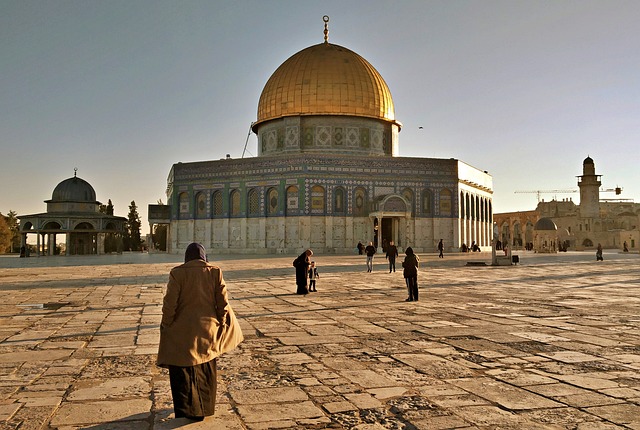Far-Right Israeli Minister Ignites Uproar with Al-Aqsa Prayer Amid Gaza Crisis
Middle East — August 4, 2025 | 5 min read
In a defiant and incendiary move, far-right Israeli National Security Minister Itamar Ben-Gvir on Sunday visited the highly volatile Al-Aqsa Mosque compound in Jerusalem and performed Jewish prayers—an act explicitly forbidden under longstanding arrangements at the contested site. The visit has unleashed a torrent of condemnation across the region, even as Gaza reels from soaring famine and the deadly chaos surrounding humanitarian aid efforts.
Footage released on Ben-Gvir’s official X (formerly Twitter) account showed the minister standing near the Dome of the Rock, deep within the Al-Aqsa compound—revered by Jews as the Temple Mount and sacred to Muslims as the Noble Sanctuary. His presence, and his prayers, shattered a decades-old understanding: Jews may visit the site but not pray, in order to preserve a fragile religious equilibrium.
The Prime Minister’s office moved quickly to assert that Israel’s official policy toward the compound remains unchanged. But that did little to temper the international outcry.
Ben-Gvir’s appearance coincided with the grim news from Gaza, where hospitals reported that 33 more Palestinians searching for food were killed by Israeli gunfire—part of a spiraling humanitarian catastrophe that has drawn fierce criticism of Israel’s conduct during its nearly two-year military campaign.
The compound itself is the epicenter of centuries-old religious contention. It houses Islam’s third-holiest mosque and stands atop the ruins of Judaism’s ancient temples. Any deviation from its strict protocols ignites fears of wider unrest, particularly amid a climate already thick with tension.
Ben-Gvir’s visit came days after Hamas released footage of two frail Israeli hostages, emaciated and speaking from dimly lit tunnels beneath Gaza. The disturbing imagery sparked fury inside Israel, mounting pressure on the government to act. Some believe Ben-Gvir’s timing was no coincidence.
The minister, known for his extremist rhetoric, renewed calls for Israel to annex Gaza entirely and urged the displacement of Palestinians—an incendiary proposal that has only complicated ongoing international mediation efforts. He dismissed the hostage videos as manipulation and declared they would not deter Israel’s path.
Ben-Gvir has previously sparked violence with visits to the site. His actions have drawn threats from militant groups and contributed to flare-ups, including the 2021 conflict that erupted into an 11-day war.
Sunday’s prayer triggered a swift and sweeping rebuke: Jordan—guardian of the Al-Aqsa Mosque—branded the move a “reckless provocation.” Palestinian leaders accused Israel of systematically undermining their rights. Saudi Arabia and Turkey joined in condemning the act. In Yemen, Houthi rebels claimed to have launched three drones at Israel in response. Israel said one “suspicious aerial object” was intercepted.
The hostage videos, released separately by Hamas and Islamic Jihad, detailed dire conditions: little food, no medicine, constant fear. The footage jolted the Israeli public. Tens of thousands rallied in Tel Aviv, demanding the government and its U.S. allies act urgently to bring the captives home. Ceasefire talks, however, remain suspended.
Israel has called for an emergency session of the U.N. Security Council to address the hostage crisis. “They don’t want a deal,” said Prime Minister Netanyahu of Hamas. “They want to break us with images of horror.” His office reported appealing to the Red Cross for access to the hostages, while the organization expressed “deep shock” at the footage and reiterated its plea for humanitarian access.
Hamas’ military wing responded, saying it was willing to cooperate—if consistent humanitarian corridors were opened throughout Gaza.
Meanwhile, the war’s toll deepened. The Palestinian Red Crescent Society reported an aid worker was killed in an Israeli strike on its office. The Red Cross denounced the incident, lamenting the mounting death toll among medical personnel. Israel said it was reviewing the report.
Eyewitnesses in Gaza described scenes of chaos and desperation. Gunfire erupted as starving civilians approached aid distribution points. In Khan Younis’ Teina area, 11 people were reported killed while attempting to access food.
Witness Yousef Abed told the Associated Press, “I saw three people bleeding. I couldn’t stop to help. The bullets were still flying.”
Two Gaza hospitals reported receiving dozens of bodies from areas near Israeli-supported Gaza Humanitarian Foundation (GHF) food sites. Palestinian eyewitnesses said soldiers opened fire on people attempting to reach these zones, which lie within militarized corridors. Israel denied any direct fire on civilians and said no casualties were known from its operations near aid sites.
From May 27 to July 31, the U.N. reported 859 deaths near GHF sites. The agency says hundreds more have died trying to reach U.N.-coordinated convoys. GHF said its armed staff used only non-lethal means—pepper spray and warning shots—to prevent stampedes.
Meanwhile, the Gaza health ministry reported six more malnutrition-related deaths among adults in the past 24 hours, bringing the five-week total to 82. An additional 93 children have died of starvation since the conflict began—figures not included in the war casualty count.
Despite recent Israeli statements touting increased aid deliveries—1,200 trucks and numerous airdrops—relief organizations report little change on the ground. The U.N. estimates 500 to 600 trucks per day are needed to meet basic needs.
The war’s origins date back to October 7, 2023, when a Hamas-led attack killed 1,200 Israelis and took 251 hostages. Israel’s response has since killed over 60,800 Palestinians, according to Gaza’s health ministry. Though Israel contests the numbers, it has provided no alternative figures. International bodies continue to regard the ministry’s tolls as the most credible in the absence of transparent Israeli data.
Once again, Jerusalem stands on the edge. Ben-Gvir’s prayer may last only minutes, but its reverberations could echo for weeks.
